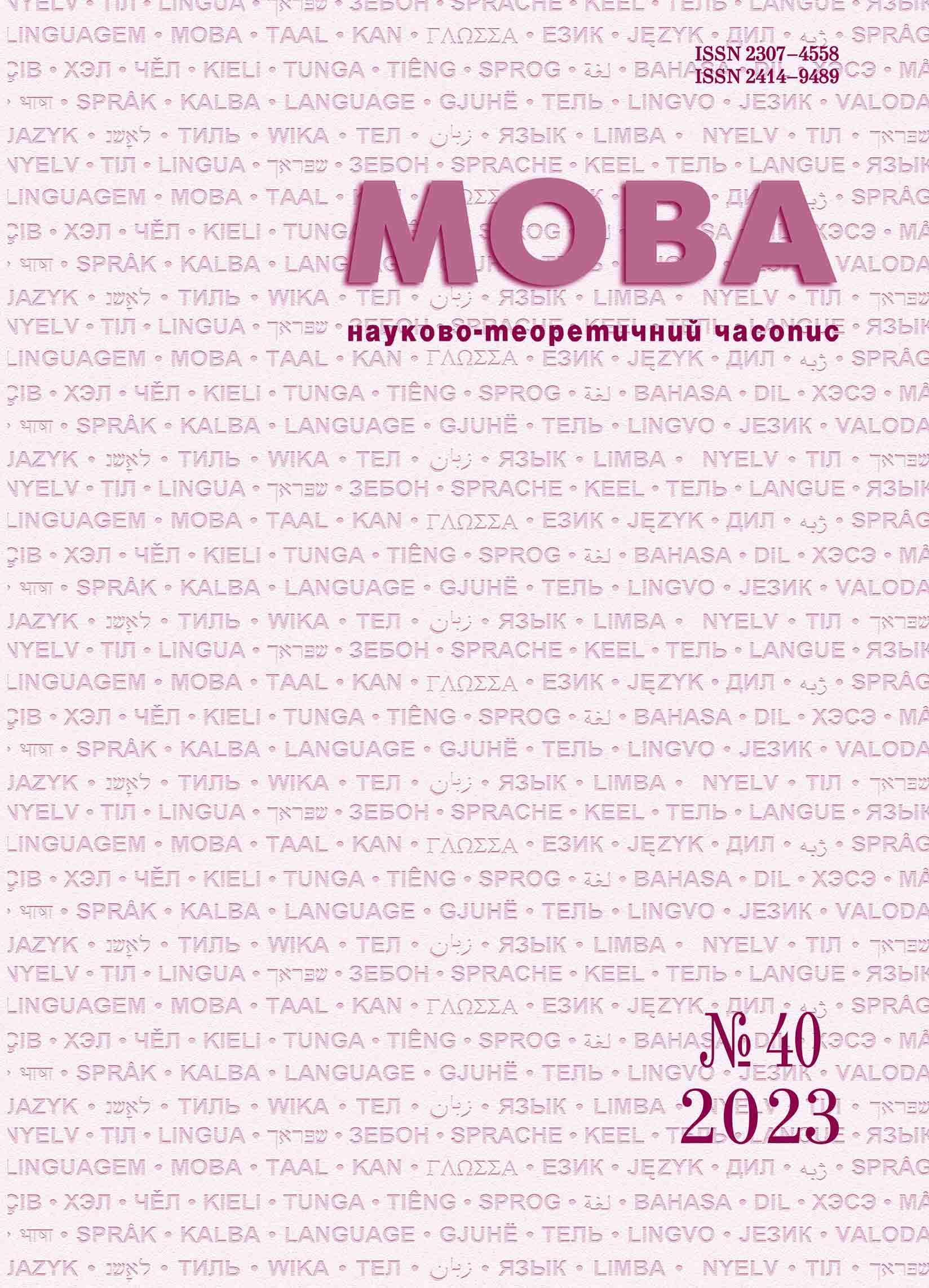ВЕРБАЛЬНІ ЗАСОБИ ТВОРЕННЯ ХУДОЖНЬОГО ЧАСУ В АНГЛОМОВНОМУ НАРАТИВІ (НА МАТЕРІАЛІ ТВОРУ ДЖ. К. РОЛІНҐ “HARRY POTTER AND THE GOBLET OF FIRE” МОВОЮ ОРИГІНАЛУ ТА УКРАЇНСЬКОГО ПЕРЕКЛАДУ В. МОРОЗОВИМ І С. АНДРУХОВИЧ)
DOI:
https://doi.org/10.18524/2307-4558.2023.40.300481Ключові слова:
англійсько-український переклад, наратив, художній час, аналепсис, пролепсис, час наративу та час нарації, анахронія, ахронія, ретроспекція, хронологічний порядок, Дж. К. Ролінґ, Гаррі ПоттерАнотація
Об’єктом дослідження є вербальні засоби творення художнього часу в англомовному фентезійному наративі. Мета — розгляд способів використання прийомів і засобів творення художнього часу в тексті наративу (аналепсис, пролепсис, анахронія, ахронія та інші, за Ж. Женеттом) на матеріалі четвертої частини септології пригод про Гаррі Поттера «Гаррі Поттер і келих вогню» Дж. К. Ролінґ. Особливу увагу приділено вживанню вербальних і невербальних засобів із темпоральними значеннями. Методи дослідження: виокремлення й аналіз вербальних засобів творення художнього часу цього наративу в оригінальному тексті британської авторки та в тексті українського перекладу В. Морозова і С. Андрухович; перекладацький аналіз твору; статистичний аналіз виокремлених вербальних засобів перекладу художнього часу; визначення перекладацьких операцій. Висновки: найпопулярнішими операціями перекладу наративу Дж. К. Ролінґ у творі «Гаррі Поттер і келих вогню» є використання еквівалентних і варіативних відповідників, конкретизація та генералізація, а також опущення і додавання. Українські перекладачі В. Морозов і С. Андрухович використали стратегію комунікативно-рівноцінного перекладу.
Посилання
Cani, I. (2007), Harry Potter ou l’anti-Piter Pen. Pour en finir avec la magie de l’enfance, Fayard, Paris, 321 p.
Colbert, D. (2002; 2004), The Magical Worlds of the Lord of the Rings, Berkley Books Penguin, New York, 212 p. ISBN: 9780425187715.
Dahl, R. (1984), BFG, Puffin Books, London, 207 p.
Dällenbach, L. (1977), Le récit spéculaire essai sur la mise en abyme, Éditions du Seuil, Paris, 264 p.
Felton, T. (2022), Beyond the wand: the magic and mayhem of growing up a wizard, Ebury Spotlight, London, 246 р.
Genett, G. (1966), Figures I, Éditions du Seuil, Paris, 265 p.
Genett, G. (1969), Figures II, Éditions du Seuil, Paris, 293 p.
Genett, G. (1972), Figures III, Éditions du Seuil, Paris, 400 p.
Genett, G. (1999), Figures IV, Éditions du Seuil, Paris, 1999, 432 p.
Genett, G. (2002), Figures V, Éditions du Seuil, Paris, 336 p.
Hornby, A. S. (1995), Oxford advanced learner’s dictionary of current English, 5th ed., Oxford University Press, Oxford, 1438 p.
Leech, G. N., Short, M. H. (1981), Style in fiction: a linguistic introduction to English fictional prose, Longman, London and New York, 416 p.
Lewis-Johnes, H. (2020), The writer’s map: An Atlas of Imaginary Lands, University Chicago Press, Chicago, 256 p.
Lodge, D. (1966), Language of fiction: Essays in Criticism and Verbal Analysis of English novel, RoutLedge and Kegan Paul, London, 283 p.
Prince, G. Dictionary of narratology, University of Nebraska Press, Lincoln &London, 1992, 126 p.
Rowling, J. K. (2016), Fantastic beasts and where to find them: The original screenplay, Little, Brown, London, 293 p.
Rowling, J. K. (1999), Harry Potter and the Chamber of Secrets, Bloomsbury, London, 256 p.
Rowling, J. K. (2000), Harry Potter and the Goblet of Fire, Bloomsbury, London, 617 p.
Rowling, J. K. (2005), Harry Potter and the Half-blood Prince, Bloomsbury, London, 542 p.
Rowling, J. K. (2018), Harry Potter and the Philosopher’s Stone, Bloomsbury Children’s Books, London, Oxford, New York, New Delhi, Sydney, 247 p.
Rowling, J. K. (2014), Harry Potter and the Prisoner of Azkaban, Bloomsbury, London, 435 p.
Rowling, J. K.,Tiffany, J., Thorne, J. (2016), Harry Potter and the cursed child, Little, Brown, London, 341 p.
Yudkowsky, E. (2010), Harry Potter and the methods of rationality, available at: https://hpmor.com/
Dahl, R. (2013), BFG [VDV], A-BA-BA-HA-LA-MA-HA Publishing House, Kyiv, 272 p., ISBN: 978-617-585-054-1.
Kosiuha, O. O. (2023), “Verbal means of creating artificial space in the literature of the fantasy genre (based on the material of the narrative about Harry Potter by JK Rowling “Harry Potter and the Goblet of Fire”)”, Scientific Research Issues of South Ukrainian National Pedagogical University named after K. D. Ushynsky: Linguistic Sciences [“Verbalʹni zasoby tvorennya khudozhnʹoho prostoru u literaturi zhanru fentezi (na materiali naratyvu pro Harri Pottera Dzh. K. Roling «Harri Potter i kelykh vohnyu»)”, Naukovyy visnyk Pivdennoukrayinsʹkoho natsionalʹnoho pedahohichnoho un-tu imeni K. D. Ushynsʹkoho: Linhvistychni nauky], Astroprint Publishing House, Odesa, Vol. 37, pp. 65–78, DOI: 10.24195/2616-5317-2023-37-5.
Kosiuha, O. О. (2023), “Genre features of septology about Harry Potter: from fairy tale to Gothic literature”, Scientific Bulletin of Kherson State University, Series: German studies and intercultural communication [“Zhanrovi osoblybosti septologii pro Harri Pottera: vid kazky do hotychnoi literarury”, Naukovyi visnyk KhDU: Hermanistyka ta mizhkulturna komunikatsiya], Kherson, No. 1, pp. 18–22.
Rowling, J. K. (2003), Harry Potter and the Goblet of Fire / translated from English to Ukrainian by V. Morozov and S. Andrukhovich [Harri Potter i kelykh vohnyu / pereklaly z anhliyskoi na ukrainsku V. Morozov i S. Andrukhovych], A-BA-BA-HA-LA-MA-HA Publishing House, Kyiv, 670 p.
Sevastyuk, M. (2019), “Reproduction of stylistic dominants of Roald Dahl’s fairy tale “BFG” in Ukrainian translation”, Young scientist [“Vidtvorennya stylʹovykh dominant kazkovoyi povisti Roalʹda Dala «VDV» v ukrayinsʹkomu perekladi”, Molodyy vchenyy], Issue 2 (66), pp. 64–69.
Tsapiv, A. O. (2020), Poetics of narrative English-language literary texts for children: Grand Ph.D. thesis [Poetyka naratyvu anhlomovnykh khudozhnikh tekstiv dlya ditey: dys. … d-ra filol. nauk: 10.02.04], V. N. Karazin Kharkiv National University, Kharkiv, 419 p.
##submission.downloads##
Опубліковано
Номер
Розділ
Ліцензія

Ця робота ліцензується відповідно до Creative Commons Attribution-NonCommercial 4.0 International License.
Правовласниками опублікованого матеріалу являються авторський колектив та засновник журналу на умовах, що визначаються видавничою угодою.
Публікація праць в Журналі здійснюється на некомерційній основі.

